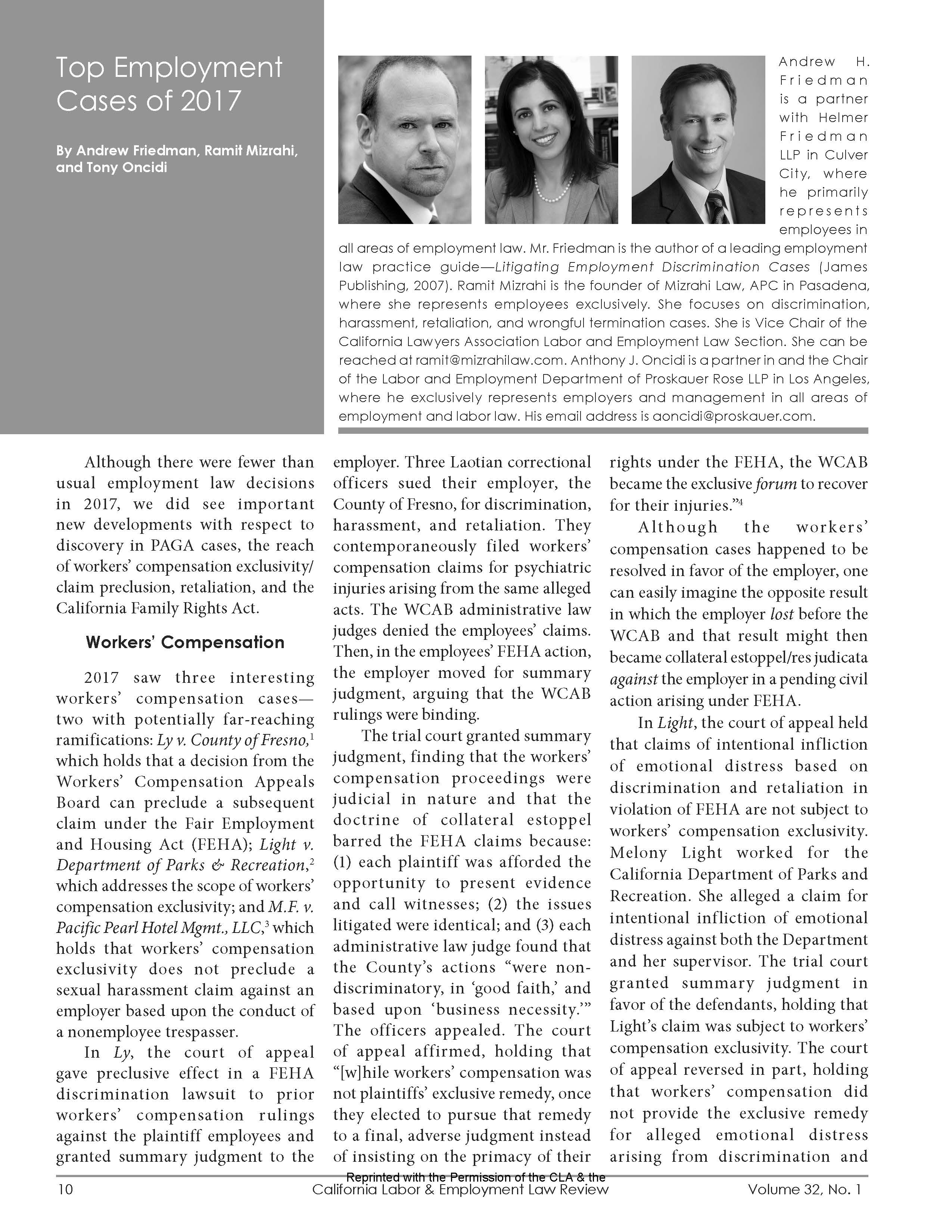-
The January 2018 issue of the California Lawyers Association’s Labor & Employment Law Review features an article authored by Andrew Friedman, Ramit Mizrahi, and Tony Oncidi.
The article—”The Top Employment Cases of 2017″— highlights the most important California state and federal employment cases from last year. Click on the below image to read the article in full.
-

On March 1, 2018, Ramit Mizrahi will be presenting at the California Lawyers Association’s Employment Law 101 conference. The conference is designed to teach fundamentals to lawyers new to employment law. She will be presenting on two panels: harassment, discrimination & retaliation (9-10:30 a.m.) and leave law compliance (1:15-2:45 p.m.).
Date and time: March 1, 2018, 9 a.m.– 4:30 p.m.
Location: The State Bar of California, 845 S. Figueroa St., Los Angeles, CA 90017.
-

On December 22, Ramit Mizrahi appeared on AirTalk (hosted by Larry Mantle) at KPCC to discuss how companies are using Facebook to target ads to younger employees, and how this can run afoul of anti-discrimination laws.The episode can be found here: Age discrimination lawsuit against big employers exposes snag in Facebook’s targeted ad system.
More Of Ramit’s Thoughts On Why Targeted Job Ads Are So Troubling
Gone are the days when people would get the local paper to scope out job ads. These days, most jobs are posted online. While there are dedicated job sites like Monster or CareerBuilder, employers are increasingly posting on Facebook.
There are many benefits to using Facebook to post jobs ads. Many potential employees are not on LinkedIn and do not have résumés posted online. Facebook has nearly 2 billion users who can be reached, including people who may not be looking to change their job situation but may be enticed to make a change. In addition, employers have the ability to microtarget, limiting their ads to people with specific interests or experience, enabling them to seek out the employees they believe will be most suitable for jobs.
Targeting Job Ads By Age Can Be Devastating to Older Workers
The problem is that employers can target ads to viewers not only by interests but also by protected characteristics, including age and gender. Working in collaboration, Propublica and the New York Times revealed that dozens of large companies–including Verizon, Amazon, UPS, and even Facebook itself–were posting job ads on Facebook that were visible only to those in certain age ranges (to give some examples, 18-24, 25-36, 27-40, and 25 to 60).
Such a practice makes job postings invisible to older workers. This means that they may never
-

On October 21, 2017, Ramit Mizrahi will once again be speaking about the year’s most important employment law cases. The panel will be part of the California Employment Lawyers Association’s 30th Annual Employment Law Conference. She will be speaking alongside Andrew H. Friedman of Helmer Friedman, LLP.
Date and time: October 21, 2017, 10 a.m.–12:05 p.m.
Location: Oakland Marriott City Center
Additional information can be found on the CELA events page.
-

Despite the federal Equal Pay Act of 1963 being on the books for over 50 years and California having its own Equal Pay Act, the gender wage gap has persisted.
According to research cited by the California legislature, women in California still earn 84 cents for every dollar earned by a male counterpart. This is sightly better than the nationwide average of 80 cents. The wage gap is even wider for women of color (for example, African-American women earn 63 cents and Latinas earn 54 cents per male dollar). Closing the wage gap would give an additional $8,000 on average to each working woman in California—an additional $39 billion in total, benefiting families and the economy.
As I have written before, one of the reasons that the wage gap persists is that women’s lower prior salary is used to justify paying them less at new jobs. This means that a new employer without intentional bias can perpetuate the pay gap by relying on what may have been the result of bias elsewhere. The lifetime cost to women can be tremendous.
AB-168, authored by Assemblymember Susan Talamantes Eggman (D-Stockton) and signed into law by Governor Brown, seeks to close the gender pay gap. The newly enacted bill adds California Labor Code section 432.3.
Under section 432.3, effective January 1, 2018:
- Employers can no long ask job applicants about their salary history, including compensation and benefits.
- Employers can no longer consider prior salary as a factor in determining whether to offer an applicant a job or what salary to set for the position.
- Employers are required, upon request, to provide a job applicant with the pay scale for the position.
- A job applicant may still decide to voluntarily (without prompting) disclose their salary history information, and employers may consider voluntarily disclosed information when setting compensation.
The bill applies to all California employers, private and public.
Exempt from Section 432.3 is salary information that is subject to public disclosure pursuant to state and federal law, including the California Public Records Act and the Freedom of Information Act.
Hopefully, this new law will have a major impact on closing the wage gap.
-

UPDATE: On January 1, 2021, the California Family Rights Act (“CFRA”) was expanded to cover employees who work for employers with five or employees; as a result the New Parent Leave Act was rendered unnecessary and was repealed. While the New Parent Leave Act was short-lived, it was a stepping stone to provide more new parents with leave rights.
Read more about SB 1383, which expanded the CFRA, here.
Expansion of bonding rights for California parents
Thanks to the SB-63, introduced by Senator Hannah-Beth Jackson, California parents who work for smaller employers will now be allowed to take up to 12 weeks of unpaid job-protected leave to bond with a new child. During that time, their employers will be required to continue their group health coverage benefits. Government Code Section 12945.6, known as the New Parent Leave Act, will make bonding leave available to millions of additional workers — an estimated 16% of the California workforce who did not previously have this right.
Eligibility requirements
To be eligible for the 12 weeks of leave under the New Parent Leave Act, the following criteria apply:
- The employee must have at least 12 months of service with the employer;
- The employee must have at least 1,250 hours of service during the prior 12 months; and
- The employee must works at a worksite with at least 20 employees within 75 miles.
The employee can take the bonding leave within one year of a child’s birth, adoption, or foster care placement.
Existing law, the California Family Rights Act (“CFRA”), provides similar parental leave rights…
-

This series, beginning here, explores the top ten ways that employers deny employees their medical leave rights.#10 – Failing To Return Employees To Vacant Positions For Which They Are Qualified
Even if a disabled employee is unable to return to her own position, an employer’s obligations do not end there. If there is a “comparable” or “lower graded” vacant position for which the employee is qualified and capable of performing with or without accommodation, the employer must offer it to her. (Nealy v. City of Santa Monica (2015) 234 Cal.App.4th 359, 377 [citing Cal. Code Regs., tit. 2, § 11068, subd. (d)(1), (2).]) Note that the Fair Employment and Housing Act (“FEHA”) does not require the employer to promote the employee or create a new position for the employee to a greater extent than it would create a new position for any employee, regardless of disability. (Ibid. [citing Cal. Code Regs., tit. 2, § 11068, subd. (d)(4)].)
An employer must offer a disabled employee the vacant position without requiring the employee to compete against other employees. (See Jensen v. Wells Fargo Bank (2000) 85 Cal.App.4th 245, 265 [“[T]o the extent Wells Fargo rejected Jensen for positions for which she was qualified because it had applicants who were more qualified or had seniority, it overlooks that when reassignment of an existing employee is the issue, the disabled employee is entitled to preferential consideration.”]). The onus is on the employer to search its positions and to make the offer (rather than simply telling the employee that she is free to search for vacant positions).
Even if there are currently no vacant positions, but openings are anticipated in the near future, the employer should extend the employee’s leave until that time. (See Nadaf-Rahrov v. Neiman Marcus Grp., Inc. (2008) 166 Cal.App.4th 952, 968 [where employee was terminated after her doctor placed her on a medical leave and extended it seven times, for a total of approximately nine months of leave, and indicated that at the end she would need to return to a different position, summary judgment was improper because “it may have been a reasonable accommodation for Neiman Marcus to extend Nadaf–Rahrov’s leave of absence for a limited period of time until a position became available that Nadaf–Rahrov could perform, particularly if Neiman Marcus could have anticipated the future opening”].) . ..
-
28 Aug '17

This series, beginning here, explores the top ten ways that employers deny employees their medical leave rights.#9 – Forcing Employees To Be Out On Leave Instead Of Offering A Different Reasonable Accommodation
An employer may not force an employee to go out or remain on leave if the employee can work with a reasonable accommodation. (Cal.Code Regs., tit. 2, § 11068, subd. (c).) Yet, employers frequently force employees to remain on unpaid leaves of absence because they incorrectly assume that the employees cannot perform their essential job functions or because they are not willing to offer reasonable accommodations that would allow the employees to work.
In Wallace v. County of Stanislaus, a deputy sheriff was placed on an unpaid medical leave of absence because of his employer’s incorrect assessment that he could not safely perform his duties even with reasonable accommodation. ((2016) 245 Cal.App.4th 109, 134, reh’g denied (Mar. 24, 2016), review denied (May 11, 2016).) The court of appeal held that the employer must face the consequences of its error:
[T]he Legislature intended to “provide protection when an individual is erroneously or mistakenly believed to have any physical or mental condition that limits a major life activity.” (§ 12926.1, subd. (d), italics added.) In light of this clear expression of legislative intent, County cannot rely on its mistaken beliefs about Wallace’s physical condition and safety to claim its reasons were legitimate under California law. . . .
-

This series, beginning here, explores the top ten ways that employers deny employees their medical leave rights.#8 – Misidentifying Medical Leave As “Indefinite”
There is only one bright-line rule when it comes to leave as a reasonable accommodation: an employer is not required to provide an employee with “indefinite” leave. (See, e.g., Cal. Code Regs., tit. 2, § 11068, subd. (c).) The rationale behind this rule is that leave as a reasonable accommodation is meant to allow an employee to recuperate and return to work. If the employee cannot say whether and when he can return to work, an employer cannot be required to hold that employee’s position.
Sometimes employers deem a leave request indefinite because the return-to-work date is not precise or may be subject to reevaluation. However, an employee seeking leave need not show that the leave is certain or even likely to be successful in proving that it is a reasonable accommodation; the employee need only show it would plausibly enable the employee to return and perform his job. (Humphrey v. Mem’l Hosps. Ass’n (9th Cir. 2001) 239 F.3d 1128, 1136.)
The EEOC has made the following point: “In certain situations, an employee may be able to provide only an approximate date of return. Treatment and recuperation do not always permit exact timetables. Thus, an employer cannot claim undue hardship solely because an employee can provide only an approximate date of return.” (EEOC Enforcement Guidance on Reasonable Accommodation and Undue Hardship under the ADA (Oct. 17, 2002), at Q&A 44.)
Thus, an employer may not treat as indefinite leave one with an approximate return date or where the situation changes and the original return date has been revised. (See Garcia-Ayala v. Lederle Parenterals, Inc. (1st Cir. 2000) 212 F.3d 638, 648-50 [discussing difference between indefinite leave and one with approximate or revised return dates].)
-
16 Aug '17

This series, beginning here, explores the top ten ways that employers deny employees their medical leave rights.#7 – Instituting a “No Fault” Attendance Policy
Also subject to challenge are “no fault” attendance policies in which employees are subject to discipline for reaching a certain number of absences, regardless of the cause of the absences. Such policies adversely affect people with disabilities, and can evidence a failure to accommodate if they do not make exceptions for individuals whose “chargeable absences” were caused by their disabilities. In 2011, Verizon entered into a settlement with the EEOC in which it agreed to pay $20 million to settle a nationwide class disability discrimination lawsuit that challenged its no-fault attendance policy. (See Verizon to Pay $20 Million to Settle Nationwide EEOC Disability Suit (July 6, 2011).)
Mizrahi Law Blog
Mizrahi Law, APC
- 35 N Lake Ave, Ste 710, Pasadena, California 91101
- contact@mizrahilaw.com
- (626) 380-9000
Client Testimonial
“I highly recommend Ramit Mizrahi. She has a winning combination of knowledge, passion, strategy, and empathy. She takes action and communicates updates promptly. Her professionalism is hard to beat. I’d give her 10 stars if I could!”
Latest News
- Ramit Mizrahi has been recognized as one of the Top 100 Super Lawyers and Top 50 Women Super Lawyers in Southern California in 2023.
- Ms. Mizrahi is being recognized in the 2023 Edition of The Best Lawyers in America©, published by U.S. News & World Report and by Best Lawyers.
- Ms. Mizrahi has been selected as a Top Attorney by Pasadena Magazine for 2023.
- Ms. Mizrahi is serving as Chair of the Pasadena Bar Association Labor and Employment Section.

